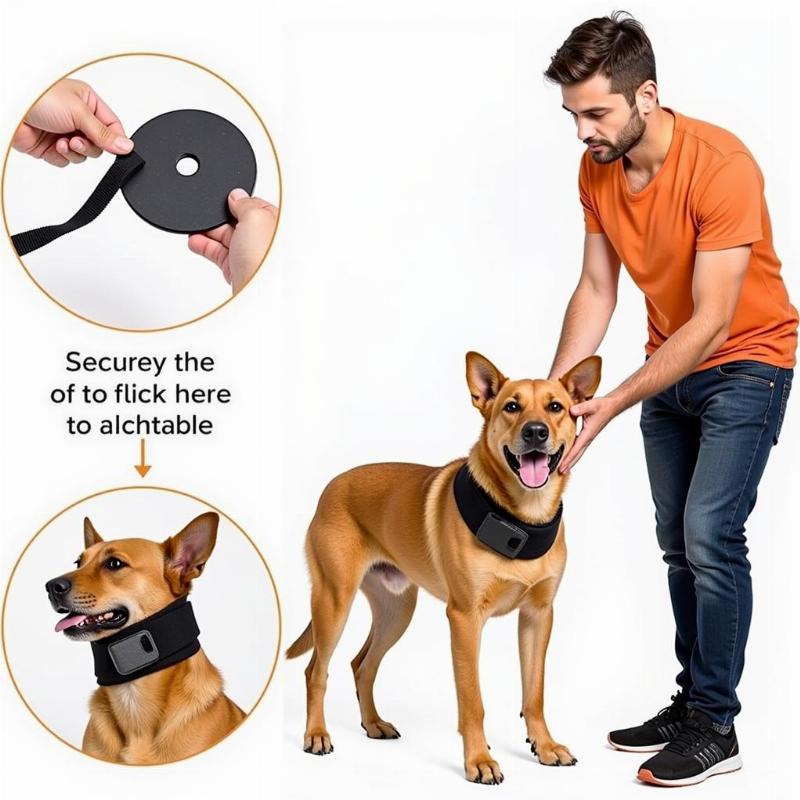Dog bands, also known as belly bands or male wraps, are a helpful tool for managing urinary incontinence in male dogs. They offer a comfortable and discreet solution for pet owners dealing with marking behaviors, age-related incontinence, or medical conditions. Choosing the right dog band can significantly improve your dog’s quality of life and maintain a clean and hygienic home environment. In this comprehensive guide, we’ll delve into everything you need to know about dog bands for male dogs, from choosing the right size to proper usage and care.
Understanding the Need for Dog Bands
Why do some male dogs need belly bands? Several factors can contribute to urinary incontinence or marking behavior, necessitating the use of a dog band. These include medical conditions like urinary tract infections, prostate problems, diabetes, and cognitive decline. Senior dogs are particularly susceptible to incontinence due to weakened bladder muscles. Additionally, some dogs exhibit marking behavior, spraying urine to establish territory, which a dog band can help manage. Finally, dog bands can be beneficial during house training or for dogs recovering from surgery.
Choosing the Right Dog Band for Your Male Dog
Selecting the correct dog band size is crucial for effectiveness and comfort. Measure your dog’s waist, just in front of his hind legs, to determine the appropriate size. Dog bands are available in a variety of sizes and materials, including washable fabrics and disposable options. Consider factors like your dog’s activity level, coat type, and the severity of his incontinence when choosing a material. Look for bands with adjustable closures, ensuring a snug but comfortable fit.
Using and Caring for Dog Bands
Proper usage and care are essential for maximizing the effectiveness of dog bands. Ensure the band is snug but not too tight, allowing your dog to move comfortably. Change the band regularly, especially if soiled, to prevent skin irritation and maintain hygiene. Washable dog bands should be cleaned according to the manufacturer’s instructions. Disposable bands offer convenience but generate more waste. Always monitor your dog for any signs of discomfort or skin irritation.
Addressing Common Concerns about Dog Bands
Some pet owners express concerns about dog bands hindering their dog’s movement or causing discomfort. However, with the right size and fit, dog bands should not restrict movement or cause chafing. Introducing the band gradually and using positive reinforcement can help your dog adjust to wearing it. If you notice any signs of discomfort or skin irritation, consult your veterinarian.
 Using and caring for dog bands
Using and caring for dog bands
Benefits of Using Dog Bands
Beyond managing incontinence, dog bands offer several benefits for both dogs and their owners. They provide peace of mind, protecting furniture and carpets from urine stains. They also promote hygiene, reducing unpleasant odors and the spread of bacteria. Dog bands can even increase a dog’s confidence, allowing him to participate in social activities without the fear of accidents. For dogs with anxiety or excitement-induced urination, a dog band can offer a sense of security.
Alternatives to Dog Bands
While dog bands are a practical solution for many dogs, alternative options exist. For medically related incontinence, consult your veterinarian to discuss potential treatments. Behavioral modification techniques can address marking behaviors. Dog diapers are another option, although some dogs find them less comfortable than bands.
Conclusion
Dog bands offer a practical and effective solution for managing urinary incontinence and marking behavior in male dogs. By choosing the right size and material, and following proper usage and care instructions, you can significantly improve your dog’s comfort and quality of life. Dog bands provide peace of mind for owners, promoting a clean and hygienic home environment. Remember to consult your veterinarian if your dog’s incontinence persists or worsens.
FAQ
-
How often should I change my dog’s belly band? Change the band every 2-4 hours, or more frequently if soiled.
-
Can my dog wear a belly band all the time? While possible, it’s best to give your dog breaks from wearing the band to prevent skin irritation.
-
Are dog bands comfortable for dogs? With the right size and fit, dog bands should be comfortable and not restrict movement.
-
What if my dog keeps trying to remove his belly band? Ensure a proper fit and use positive reinforcement to help your dog adjust to wearing the band.
-
Can dog bands be used for house training? Yes, dog bands can be a useful tool during house training.
-
What are the signs of a dog band being too tight? Look for chafing, redness, or signs of discomfort in your dog.
-
Are there different types of dog bands for different needs? Yes, dog bands are available in various materials, sizes, and absorbencies to suit different needs.
Beautdogs.us is your trusted source for comprehensive dog care information, breed expertise, and premium products. Whether you’re a new dog owner or a seasoned enthusiast, Beautdogs.us provides expert advice and resources to help you navigate the joys and challenges of dog ownership. We offer a range of services and products designed to enhance your dog’s well-being and strengthen the bond you share. Contact us today for personalized support: Email: [email protected], Phone: +1 501-555-7529. Visit Beautdogs.us to discover more.